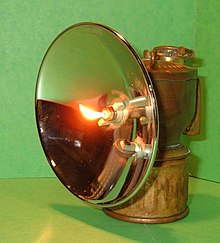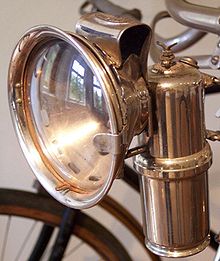| Revision as of 16:08, 27 November 2020 editDenis Zhilin (talk | contribs)3 edits →External links: a link to youtube was added.Tag: Reverted← Previous edit | Revision as of 22:58, 27 November 2020 edit undoWtshymanski (talk | contribs)Extended confirmed users76,137 edits .en Undid revision 990974438 by Denis Zhilin (talk)Tag: UndoNext edit → | ||
| Line 114: | Line 114: | ||
| * Demonstration experiment: Instruction and video | * Demonstration experiment: Instruction and video | ||
| * A website on the history, restoration, and use of carbide lamps for caving. | * A website on the history, restoration, and use of carbide lamps for caving. | ||
| * Carbide lamp in action. | |||
| {{Artificial light sources}} | {{Artificial light sources}} | ||
Revision as of 22:58, 27 November 2020
Acetylene-burning lamps See also: Headlamp (outdoor)| This article needs additional citations for verification. Please help improve this article by adding citations to reliable sources. Unsourced material may be challenged and removed. Find sources: "Carbide lamp" – news · newspapers · books · scholar · JSTOR (July 2015) (Learn how and when to remove this message) |

Carbide lamps, or acetylene gas lamps, are simple lamps that produce and burn acetylene (C2H2) which is created by the reaction of calcium carbide (CaC2) with water (H2O).
Acetylene gas lamps were used to illuminate buildings, as lighthouse beacons, and as headlights on motor-cars and bicycles. Portable acetylene gas lamps, worn on the hat or carried by hand, were widely used in mining in the early twentieth century. They are still employed by cavers, hunters, and cataphiles. Small carbide lamps called "carbide candles" or "smokers" are used for blackening rifle sights to reduce glare. They are used because of the sooty flame produced by acetylene.
Mechanism


A mining or caving lamp has calcium carbide placed in a lower chamber, the generator. The upper reservoir is then filled with water. A threaded valve or other mechanism is used to control the rate at which the water is allowed to drip into the chamber containing the calcium carbide. By controlling the rate of water flow, the production of acetylene gas is controlled. This, in turn, controls the flow rate of the gas and the size of the flame at the burner, and thus the amount of light it produces.
This type of lamp generally has a reflector behind the flame to help project the light forward. An acetylene gas powered lamp produces a bright, broad light. Many cavers prefer this type of unfocused light as it improves peripheral vision in the complete dark. The reaction of carbide with water is exothermic and produces a fair amount of heat independent of the flame. In cold caves, carbide lamp users can use this heat to help stave off hypothermia.
Chemical reactions
See also: Production of acetyleneAcetylene is produced by the reaction:
The acetylene combusts easily in the atmosphere:
When all of the carbide in a lamp has been reacted, the carbide chamber contains a wet paste of slaked lime (Ca(OH)2) which can be used to make a cement. This is emptied into a waste bag and the chamber can be refilled.
History

In 1892, Thomas Willson discovered an economically efficient process for creating calcium carbide in an electric arc furnace from a mixture of lime and coke. The arc furnace provides the high temperature required to drive the reaction. Manufacture of calcium carbide was an important part of the industrial revolution in chemistry, and was made possible in the US as a result of massive amounts of inexpensive hydroelectric power produced at Niagara Falls before the turn of the twentieth century. In 1895, Willson sold his patent to Union Carbide. Domestic lighting with acetylene gas was introduced circa 1894 and bicycle lamps from 1896. In France, Gustave Trouvé, a Parisian electrical engineer, also made domestic acetylene lamps and gasometers.
The first carbide bicycle lamp developed in the United States was patented in New York on August 28, 1900 by Frederick Baldwin. Another early lamp design is shown in a patent from Duluth, Minnesota on October 21, 1902. In the early 1900s, Gustaf Dalén invented the Dalén light. This combined two of Dalén's previous inventions: the substrate Agamassan and the Sun valve. Inventions and improvements to carbide lamps continued for decades.
After carbide lamp open flames were implicated in an Illinois coal-seam methane gas explosion that killed 54 miners, the 1932 Moweaqua Coal Mine disaster, carbide lamp use declined in United States coal mines. They continued to be used in the coal pits of other countries, notably USSR.
In the birth of the cinema of Iquitos, a carbide lamp was used as light support to project the first film in the Casa de Fierro, in 1900.
Lighting systems

Carbide lighting was used in rural and urban areas of the United States which were not served by electrification. Its use began shortly after 1900 and continued past 1950. Calcium carbide pellets were placed in a container outside the home, with water piped to the container and allowed to drip on the pellets releasing acetylene. This gas was piped to lighting fixtures inside the house, where it was burned, creating a very bright flame. Carbide lighting was inexpensive but was prone to gas leaks and explosions.
Early models of the automobile, motorbike and bicycle used carbide lamps as headlamps. Acetylene gas, derived from carbide, enabled early automobiles to drive safely at night. Thick concave mirrors combined with magnifying lenses projected the acetylene flame light. These type of lights were used until reliable batteries and dynamos became available, and manufacturers switched to electric lights.
Acetylene lamps were also used on riverboats for night navigation. The National Museum of Australia has a lamp made in about 1910 that was used on board PS Enterprise, a paddle steamer which has been restored to working order and also in the museum's collection.
They are also used for night hunting.
Use in caving

Early caving enthusiasts, not yet having the advantage of light-weight electrical illumination, introduced the carbide lamp to their hobby. While increasingly replaced by more modern choices, a substantial percentage of cavers still use this method.
In cave surveys, carbide lamps are favoured for the lead or "point" surveyor, who must identify suitable points in the cave to designate as survey stations. The sooty carbide flame may be used to mark cave walls with a station label. Especially favoured for this purpose are all-brass lamps or lamps made with no ferromagnetic metals, as these lamps do not deflect the needles of a magnetic compass, which is typically read while brightly illuminated from above using the caver's lamp.
Apart from their use as cave surveying tools, many cavers favour carbide lamps for their durability and quality of illumination. They were once favoured for their relative illumination per mass of fuel compared to battery powered devices. Before the advent of high-intensity LED illumination with lithium ion batteries, carbide also had two important advantages over the alternative of miners electric lamps. Miners lamps were intended to last for the duration of a standard working shift, whilst major caving explorations could be much longer, so the carbide could be replenished during the trip. Expeditions involving camping over several days in remote regions might not have access to electricity for recharging. Lamps used in such circumstances would consist of a belt mounted gas generator linked by flexible pipe to a headset.
The acetylene producing reaction is exothermic, which means that the lamp's reactor vessel will become quite warm to the touch; this can be used to warm the hands. The heat from the flame can also be used to warm the body by allowing the exhaust gases to flow under a shirt or poncho pulled out from the body, a technique discovered almost immediately by cold miners, and nicknamed by cavers the "Palmer furnace".
See also
Notes
- Patnaik, Pradyot (2003). Handbook of Inorganic Chemical Compounds. McGraw-Hill. ISBN 0-07-049439-8.
- Using the Super Smoker. ray-vin.com. Retrieved 11 October 2015.
- Matthews, C. E. (1996). An illuminating reaction. The Science Teacher, 63(5), 30.
- "Chemical characteristics of calcium carbide and its reaction with water". MEL Science. Retrieved 2018-05-16.
- Morehead, J. T. and de Chalmot, G. (1896). "The Manufacture of Calcium Carbide". Journal of the American Chemical Society. 18 (4): 311–331. doi:10.1021/ja02090a001.
{{cite journal}}: CS1 maint: multiple names: authors list (link) - Freeman, Horace (1919). "Manufacture of Cyanamide". The Chemical News and the Journal of Physical Science. 117: 232.
- U.S. patent 656,874
- U.S. patent 711,871
- For example on March 10, 1925 Andrew Prader of Spokane, Washington was granted U.S. patent 1,528,848
- Fifty-First Annual Coal Report of Illinois, 1932, Department of Mines and Minerals. Journal Printing Co.: Springfield, ILL., 1933
- Paddle Steamer Enterprise, National Museum of Australia
- Caving equipment and culture (from Te Ara: The Encyclopedia of New Zealand)
References
- Clemmer, Gregg (1987). American Miners' Carbide Lamps: A Collectors Guide to American Carbide Mine Lighting. Westernlore Publications. ISBN 978-0870260643.
- Pohs, Henry (1995). The Miners Flame Light Book. Flame Publishing. ISBN 978-0964116504.
- Card, Peter W. (October 2004). Early Vehicle Lighting. Shire Publications. ISBN 978-0-7478-0585-4.
- Thorpe, Dave (2005). Carbide Light: The Last Flame in American Mines. Bergamot Publishing. ISBN 978-0976090526.
External links
- acethylene.com A comprehensive guide to the care and maintenance of acetylene gas lamps
- A User's Guide to Carbide Cap Lamps. Has many good pictures & videos.
- Carbide lamp Demonstration experiment: Instruction and video
- The Carbide Caver A website on the history, restoration, and use of carbide lamps for caving.
| Lighting | |||||||||||||
|---|---|---|---|---|---|---|---|---|---|---|---|---|---|
| Concepts | |||||||||||||
| Methods of generation |
| ||||||||||||
| Stationary | |||||||||||||
| Portable | |||||||||||||
| Automotive | |||||||||||||
| |||||||||||||
| |||||||||||||
| |||||||||||||
| Related topics | |||||||||||||
| Mining equipment | |||||||||
|---|---|---|---|---|---|---|---|---|---|
| Excavation |
| ||||||||
| Transport |
| ||||||||
| Safety | |||||||||